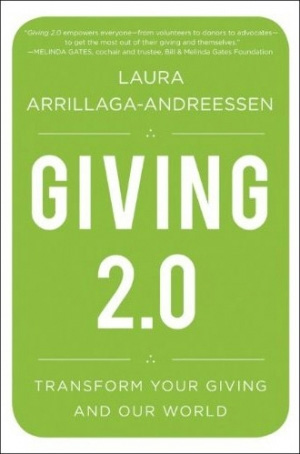


 Giving 2.0:
Giving 2.0: “Giving away money is easy—doing so effectively is much harder,” declares Laura Arrillaga-Andreessen in her introduction to Giving 2.0. It’s a common realization for those in the industry, but can still be a hard-earned truth. In language that is sometimes a little flowery, Andreessen positions philanthropy as a powerful pathway to emotional, intellectual and spiritual fulfillment, and ultimately a tool of personal and communal transformation. The book has been endorsed by a who’s who of America’s leading philanthropic leaders, including Melinda Gates, but this not entirely grounded book will likely be irrelevant to savvy givers. And if you are looking for a prescriptive how-to manual, Giving 2.0 will almost certainly fall short.
Arrillaga-Andreessen has philanthropy in her DNA. Her father is noted real estate mogul and philanthropist John Arrillaga, Sr. and her husband is Silicon Valley pioneer and investor Marc Andreessen. Thus her book is written from a place of obvious privilege. Still, Arrillaga-Andreessen has credentials. She describes herself as a “pracademic,” a practitioner as much as a scholar of charitable giving. She is founder of an organization called SV2 (the Silicon Valley Social Venture Fund), president of the Marc and Laura Andreessen Foundation, founder and chair of the Stanford Center on Philanthropy and Civil Society, and a lecturer at the Stanford Graduate School of Business, where she teaches a course on strategic philanthropy.
Giving 2.0 takes a deeply personal, anecdotal, and reflective approach to philanthropy that evolves over time. It is part philanthropic memoir inspired by the example of her mother, part conversational guide, part academic reader. Arrillaga-Andreessen provides a fair contextualization of philanthropy in historical terms and includes more than a passing mention of social media, an issue close to her family and home. She offers extensive lists of thought-provoking questions, and encourages philanthropists to learn from their giving in order to inform future gift decisions and create greater impact. Her suggestion to begin a giving journal to explore and document one’s journey towards effective philanthropy may not resonate with or be practical for everyone, but her premise that giving effectively requires a high degree of personal engagement is solid.
To her credit, Arrillaga-Andreessen consistently acknowledges her standing and addresses the often unspoken and complicated role of ego in giving. She quickly identifies the need to respectfully navigate relationships with charitable and nonprofit leaders as expert teachers and collaborators. She admits to past giving experiences that missed the mark, lending the book an air of authenticity. And she articulates the importance of advocacy and social justice philanthropy, two areas that are frequently sidelined and misunderstood, yet where systemic transformation is often rooted.
The author says she wrote Giving 2.0 for “anyone who gives anything, in any amount to create a better world.” Aspirationally, this includes donors at all giving levels (whether $10 or $10 million), volunteers, and social change advocates. The inclusive acknowledgement of the whole range of players in philanthropy is refreshing, albeit a little superficial. At the same time, it contributes to a cumbersome lack of focus and depth that doesn’t reflect Arrillaga-Andreessen’s obvious expertise.
The book may be especially useful to those who are new to intentional philanthropy, are highly motivated and want a broad survey of the “oceans of possibility.” Arrillaga-Andreessen refers to navigating these oceans herself, but the book would have benefited from more sophisticated navigation tools. More explanatory chapter titles and greater use of headings and subheadings would have made it easier to reference. Charts, checklists, and worksheets might have helped bring shape to the valuable approach, considerations and questions she offers.
Patient readers will be rewarded, however. The writing style is informal and conversational, which helps make it an accessible read in spite of the dense content. Comprehensive “Making It Happen” summaries at the end of each chapter help round things out and avoid the need for pen-in-hand reading. Philanthropists with children will also find some wonderful examples and tools to nurture and practice generosity as a family.
In the end, Giving 2.0 doesn’t offer a plan or framework to make giving easy as much as it welcomes readers to the path with a description of the many options available and a bracing call for self-reflection and exploration. Add this book to your library, but don’t expect a tell-all.